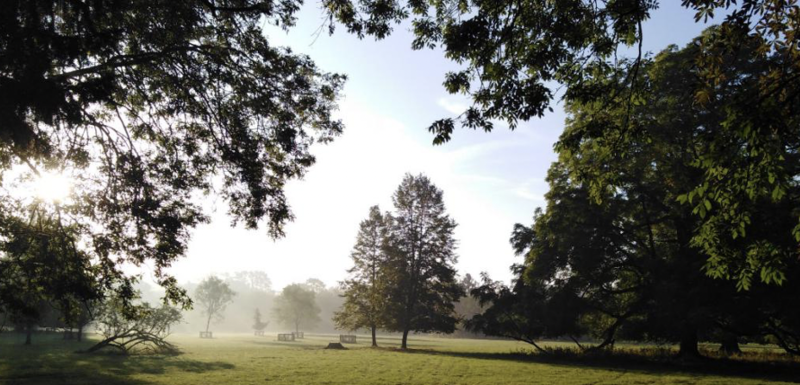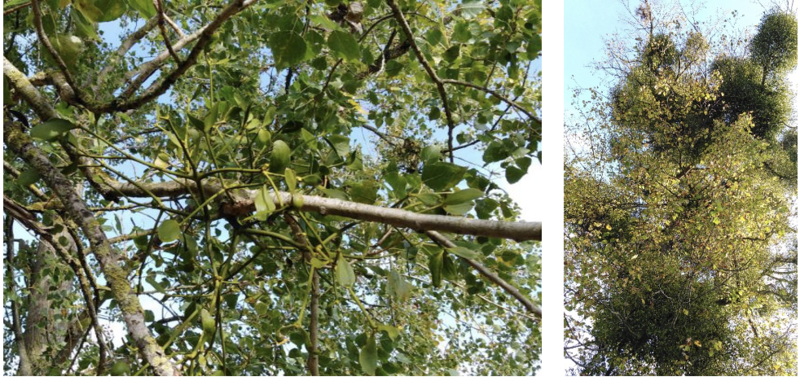A day in the life - dendro fieldwork!
(Scroll down for the Spanish version)
Hello! My name is Irene, I finished my BA in Biology at Oxford this year and I am currently in the 4th week of my year-long Masters. My project is about host-parasite relationships - specifically, how they can persist in the long-term, and focusing on the study system of European mistletoe and their host trees. My supervisors are Rob and Connor Bernard, who both have lots of experience with dendroecological fieldwork. Here’s a bit about what I’ve been getting up to recently...

Figure 1. Early morning at the grounds of Magdalen College, Oxford where there are over 50 trees with mistletoe! |Por la mañana temprano en el parque de Magdalen College, Oxford donde hay ¡más de cincuenta arboles huésped con muérdago blanco!
7.30am - a typical day starts earlier than when I would wake up for 1st year undergrad lectures! I usually check the weather forecast and wolf down some breakfast.
9am - if I’m working from home, I sit at the dining room table and get going with emails and admin. I’ve been sorting out my fieldwork, getting permission, writing risk assessments - not very exciting but necessary so that everything else goes smoothly!
12pm - might have a meeting with my supervisor and chat about my progress, more things to get organised and talk about the project: hypotheses, papers to read, questions to follow up. This is when I often swing by the Department of Zoology to gather my equipment & make final preparations for an afternoon of fieldwork.
Figure 2. Irene (left) taking a tree core sample using the increment borer (right) |Irene (izquierda) recogiendo una muestra de madera obtenida con un Taladro de Pressler (derecha).
1pm - lunch in the company of people from SalGo Team if they’re around, who I have really enjoyed getting to know! Almost everyone is working on something different to each other, with interests across ecology and varied backgrounds & life experiences, so plenty of opportunity for great conversation and lovely company. I also like to bump into & chat with others at the Department - I’ve found it to be a very welcoming atmosphere.
2pm - time to go out to the field! I’ve been at different sites, in particular at colleges, across Oxford as there is an abundance of mistletoe, Viscum album in the area. The last few weeks have mostly been filled with taking tree core samples from host trees. One of my hypotheses is that tree growth is negatively affected by mistletoe parasitism and that this is dependent on parasite load, or the number of mistletoe individuals on each host tree. I will carry out dendroecological analyses of the cores after collecting across Oxford trees, to look at how the trees have grown from the tree ring increments. I’ve got lots to read to understand this topic better and inform my thinking as I go into the analysis this autumn.
Back to the fieldwork! I collect the tree cores using an increment borer - essentially, a hollow drill with handles - that I manually rotate through the tree bark and cambium layers until it’s around 10-15cm into the tree. Using an extractor, a sharp metal tool, I then break off the core from the tree pith and extract it from within the hollow drill. I find it really enjoyable work, although quite tiring at times, with some trees easier than others! After safely storing the tree core in a paper straw, I seal the wound with beeswax to reduce the risk of fungal infection.
4.30pm - probably break time! As it is strenuous work, it’s important to replenish energy & catch my breath in between sampling. It’s great when I have a helpful assistant to join me in the field as well, to share the work & take cores more efficiently, and chat a bit too:)
6.30pm - I might collect around 15-20 cores in an afternoon, along with tree circumference data, and measurements using a laser rangefinder, to later calculate tree height. I’ll often go back to the Department to store the cores safely and then head home.

Figure 3. Mistletoe is a shoot hemi-parasite, shown here growing from a tree branch (left – light green leaves in the centre of the image), and it can grow into large spheres across the tree (right) | El muérdago blanco es un hemi-parasito que crece en las ramas de sus árboles huésped – se muestra aquí naciendo de una rama (izquierda – se pueden ver las hojas de color verde claro en el centro de la imagen), y puede llegar a convertirse en grandes esferas en todas las ramas del árbol (derecha)
7pm - catch up with my housemates, family and friends. A quiet evening in especially if I’ve been core collecting for some hours!
So far, it’s been a completely different experience to my undergraduate degree. My timetable is shifted by having fantastic fieldwork almost daily and not having weekly assignment deadlines. That may all change very soon as I begin term time again (yikes!) and as the weather turns - definitely more fun in the sunshine!
There have been new challenges and plenty to learn along the way! I am very glad to have joined SalGo Team for this year.
—
[Versión en español - traducida por Irene Barriga Garcia-Lisbona]
Un día en la vida - trabajo de campo en dendroecologia!
¡Hola! Me llamo Irene, acabo de terminar mi BA en Biología en Oxford este año y ahora estoy en la cuarta semana de mi máster de un año. Mi proyecto trata sobre las relaciones entre parásitos y sus huéspedes - específicamente, cómo pueden persistir a largo plazo y se centra en el sistema del muérdago blanco y sus árboles huésped. Mis supervisores son Rob y Connor Bernard, quienes tienen mucha experiencia con trabajo de campo dendroecológico. Ahora os cuento un poco sobre lo que he estado haciendo estos días...
7:30 - ¡Un día típico empieza más temprano que cuando me despertaba para las clases de primero! Normalmente compruebo el pronóstico del tiempo y tomo algo para desayunar.
9:00 - Si estoy trabajando desde casa, me siento en la mesa del comedor y empiezo con emails y tareas. He estado organizando mi trabajo de campo, obteniendo permisos, escribiendo evaluaciones de riesgo - no es muy emocionante pero es necesario para que todo lo demás transcurra sin problemas!
12:00 - Puede que tenga una reunión con mi supervisor para hablar sobre mi progreso, más cosas que organizar y sobre el proyecto: hipótesis, artículos que leer, preguntas para investigar. A menudo, a esta hora me paso por la Facultad de Zoología para recoger mi equipo y prepararme para una tarde de trabajo de campo.
13:00 - Almuerzo con gente de SalGo Team si están por la zona, ¡a quienes me ha encantado conocer! Casi todos investigan algo distinto, con diversos intereses académicos dentro de la ecología y vienen de diferentes sitios con diferentes experiencias de vida, lo cual crea una gran oportunidad para charlar y disfrutar de su estupenda compañía. También me gusta juntarme y hablar con otras personas de la facultad - me parece un ambiente muy acogedor.
14:00 - ¡Hora de salir al campo! He estado en varios lugares, en particular en los colleges, en Oxford ya que hay una gran cantidad de muérdago blanco, Viscum album por la zona. En las últimas semanas me he ocupado de recoger muestras de la madera de los árboles hospedantes. Una de mis hipótesis es que el crecimiento de los árboles se ve afectado negativamente por el parasitismo del muérdago y que esto depende de la carga de parásitos y del número de individuos de muérdago en cada árbol. Llevaré a cabo análisis dendroecológicos de la madera después de recoger muestras de árboles de Oxford, para investigar cómo han crecido los árboles a través del estudio de los anillos de crecimiento. Tengo mucho que leer para entender mejor este tema y ampliar mis conocimientos a medida que empiece el análisis este otoño.
Yendo de vuelta al tema del trabajo de campo... Recojo muestras de madera usando un taladro de Pressler - esencialmente, un tubo hueco con espiral y asas - que hago rotar a mano a través de la corteza y las capas de cambium hasta que esté a unos 10-15 centímetros dentro del árbol. Usando una varilla, un instrumento de metal afilado, rompo la muestra de la médula del árbol y lo extraigo del tubo del taladro. Me parece que es un trabajo muy agradable, aunque a veces bastante agotador, ¡Algunos árboles son más fáciles de perforar que otros! Después de guardar la muestra de madera cuidadosamente en una pajita de papel, sello la herida con cera de abeja para reducir el riesgo de infección micótica.
16:30 - ¡Creo que toca un descanso! Como es agotador, es importante reponer energías y recobrar el aliento entre las tomas de muestra. Es genial cuando tengo un ayudante acompañándome en el campo para compartir el trabajo y tomar muestras con más eficacia, y charlar un rato, claro :)
18:30 - Suelo recoger unas 15-20 muestras en una tarde, junto con datos de la circunferencia de los árboles, y medidas, usando un localizador Láser, para luego calcular la altura del árbol. Normalmente vuelvo a la facultad para guardar las muestras de forma segura, y luego me voy pa casa.
19:00 - Me pongo al día con mis compañeros de piso, y con la familia y amigos. Una tarde tranquila en casa, ¡especialmente si he estado recogiendo muestras durante varias horas!
Hasta ahora, ha sido una experiencia completamente distinta a lo que he hecho durante mi carrera. Mi horario ha cambiado al tener un trabajo de campo fantástico casi a diario y al no tener que entregar tareas cada semana. Puede que todo eso cambie dentro de poco cuando vuelva a comenzar el curso (¡ay!) y ahora que el tiempo empeora - ¡sin duda lo paso mejor al sol!
¡Ha habido nuevos retos y mucho que aprender por el camino! Estoy muy agradecida por haberme unido a SalGo Team este año.



